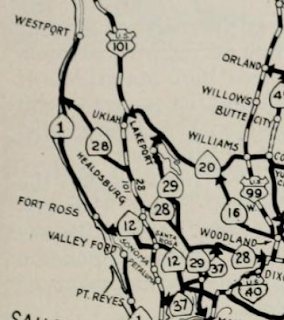The Putah Creek Bridge was a masonry structure constructed during 1896 by Napa County to serve the community of Monticello. The Putah Creek Bridge would be annexed into the State Highway System in 1933 when Legislative Route Number 6 was extended from Woodland Junction to Napa. The Putah Creek Bridge was a component of the original California State Route 28 from 1934-1952. The span briefly became part of California State Route 128 in 1953 until the highway was relocated as part of the Monticello Dam project in 1955. Today the Putah Creek Bridge sits at the bottom of the Lake Berryessa reservoir and is accessible to divers. Pictured as the blog cover is the Putah Creek Bridge as it was featured in the September 1950 California Highways & Public Works.
California State Route 28 can be seen crossing the Putah Creek Bridge near Monticello on the 1943 United States Geological Survey map of Copay.
The site of Monticello lies under the waters of the Lake Berryessa reservoir in what was once known as Berryessa Valley. The Berryessa Valley name is derived from the Berryessa family which was granted the lands of Rancho Las Putas by Mexican Governor Manual Micheltorena during 1843. The Berryessa sold their stake in Rancho Las Putas to American investors during 1853.
Rancho Las Putas was subdivided during 1866 and the farming community of Montecillo was plotted. By 1870 a franchise wagon road from Napa was constructed via a new bridge over Putah Creek. By 1875 Napa County purchased the road connecting Napa-Monticello and declared it a public highway. The highway connecting Napa-Monticello can be seen on the 1882 Bancroft's Map of California.
The history of the Putah Creek Bridge was featured in the September 1950 California Highways & Public Works Centennial Edition. The Putah Creek Bridge was referenced in the issue as being a notable example of a masonry bridge in the State Highway System (then part of California State Route 28 and Legislative Route Number 6). The Putah Creek Bridge was constructed during 1896 by Napa County. The structure was cut from native sourced sandstone and was 70 feet long. The article notes the Putah Creek Bridge was subject to being inundated if the construction of Monticello Dam proceeded.
During 1933 Legislative Route Number 6 (LRN 6) was extended from Woodland Junction to Napa by way of Monticello. The extension of LRN 6 annexed the Putah Creek Bridge into the State Highway System.
California State Route 28/LRN 6 can be seen crossing the Putah Creek Bridge near Monticello on the 1943 United States Geological Survey map of Copay.















Comments